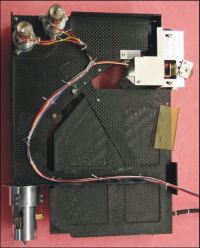Instrumented Mole System (IMS)
However, while the Pluto mole was designed to retrieve sample material and return it to the lander unit the IMS carries a payload package in a separate compartment trailing the leading tractor mole. Through such a design the payload compartment has a modular character and can be filled with any payload instruments which fit into the tight compartment.
 |
|
The carbon fibre housing of the IMS contains the tractor mole and the trailed payload compartment. Both are locked during launch with pin pullers (upper left). The lower part of the housing is filled with the tether connecting the system with the lander unit. |
The contract has delivered a breadboard of the whole system. This includes the tractor mole, the trailed mole (payload compartment) and the release and storage platform which remains on the lander unit once the mole is send into ground.
Two other development activities will produce payload candidates that demonstrate the feasibility to fill the payload compartment with a meaningful suite of scientific instruments. One contains a suite of sensors to determine thermal and mechanical properties of the soil (HP3, Heat Flow and Physical Properties Package). The other (Water Sensors for Mars) consists of a small infrared spectrometer and a humidity sensor.
The IMS development was carried under the prime contractor Galileo Avionica (Italy).
